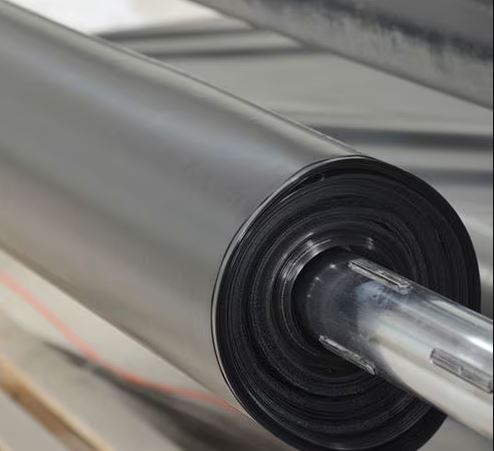Geomembrane sheets, a vital component in various engineering and environmental projects, play a crucial role in containment, protection, and preservation of natural resources and infrastructure. In this blog post, we delve into the intricacies of geomembrane sheets, exploring their composition, applications, and the numerous benefits they offer to industries worldwide.
Understanding Geomembrane Sheets
Geomembrane sheets are synthetic liners manufactured from high-density polyethylene (HDPE), polyvinyl chloride (PVC), ethylene propylene diene monomer (EPDM), or other specialized materials. These impermeable membranes are designed to contain liquids, gases, and solids, preventing their migration and protecting underlying structures and the environment.
Composition and Structure:
Geomembrane sheets typically consist of multiple layers, including a smooth or textured surface for enhanced frictional properties and a reinforcement layer for added strength and durability. The selection of materials and manufacturing processes varies depending on the specific application and environmental conditions.
Applications of Geomembrane Sheets
Geomembrane sheets find extensive use in a wide range of industries and applications, including:
Environmental Protection:
- Landfill Liners: Geomembrane sheets serve as impermeable barriers in landfill liners, preventing leachate from contaminating soil and groundwater.
- Pond and Lagoon Liners: Used in the construction of ponds, lagoons, and reservoirs, geomembrane sheets ensure water containment and prevent seepage.
- Wastewater Treatment: Geomembrane liners are employed in wastewater treatment facilities to contain and manage effluent streams effectively.
Civil Engineering and Construction:
- Canal and Dam Linings: Geomembrane sheets provide waterproofing solutions for canals, dams, and reservoirs, ensuring structural integrity and preventing water loss.
- Tunnel and Underground Structures: Used as waterproofing membranes in tunnels, underground storage tanks, and basements, geomembrane sheets offer protection against water infiltration.
Mining and Containment:
- Heap Leach Pads: Geomembrane liners are utilized in mining operations for heap leach pads, preventing the leaching of toxic chemicals into the surrounding environment.
- Tailings Pond Liners: Geomembrane sheets serve as liners for tailings ponds, containing mine waste and preventing contamination of soil and water resources.
Benefits of Geomembrane Sheets
Geomembrane sheets offer numerous advantages over traditional lining materials, including:
- Impermeability: Geomembrane sheets provide excellent resistance to liquid and gas penetration, ensuring effective containment and protection.
- Durability: With high tensile strength and puncture resistance, geomembrane sheets offer long-term performance in challenging environmental conditions.
- Flexibility: Geomembrane sheets are highly flexible and conformable, allowing for easy installation around complex geometries and irregular surfaces.
- Chemical Resistance: Geomembrane materials are resistant to a wide range of chemicals, acids, and bases, ensuring compatibility with diverse applications.
- Environmental Sustainability: By preventing contamination and preserving natural resources, geomembrane sheets contribute to environmental protection and sustainability efforts.
Understanding Geomembrane Sheets
Geomembrane sheets are synthetic liners manufactured from high-density polyethylene (HDPE), polyvinyl chloride (PVC), ethylene propylene diene monomer (EPDM), or other specialized materials. These impermeable membranes are designed to contain liquids, gases, and solids, preventing their migration and protecting underlying structures and the environment.
Composition and Structure:
Geomembrane sheets typically consist of multiple layers, including a smooth or textured surface for enhanced frictional properties and a reinforcement layer for added strength and durability. The selection of materials and manufacturing processes varies depending on the specific application and environmental conditions.
Applications of Geomembrane Sheets
Geomembrane sheets find extensive use in a wide range of industries and applications, including:
Environmental Protection:
- Landfill Liners: Geomembrane sheets serve as impermeable barriers in landfill liners, preventing leachate from contaminating soil and groundwater.
- Pond and Lagoon Liners: Used in the construction of ponds, lagoons, and reservoirs, geomembrane sheets ensure water containment and prevent seepage.
- Wastewater Treatment: Geomembrane liners are employed in wastewater treatment facilities to contain and manage effluent streams effectively.
Civil Engineering and Construction:
- Canal and Dam Linings: Geomembrane sheets provide waterproofing solutions for canals, dams, and reservoirs, ensuring structural integrity and preventing water loss.
- Tunnel and Underground Structures: Used as waterproofing membranes in tunnels, underground storage tanks, and basements, geomembrane sheets offer protection against water infiltration.
Mining and Containment:
- Heap Leach Pads: Geomembrane liners are utilized in mining operations for heap leach pads, preventing the leaching of toxic chemicals into the surrounding environment.
- Tailings Pond Liners: Geomembrane sheets serve as liners for tailings ponds, containing mine waste and preventing contamination of soil and water resources.
Benefits of Geomembrane Sheets
Geomembrane sheets offer numerous advantages over traditional lining materials, including:
- Impermeability: Geomembrane sheets provide excellent resistance to liquid and gas penetration, ensuring effective containment and protection.
- Durability: With high tensile strength and puncture resistance, geomembrane sheets offer long-term performance in challenging environmental conditions.
- Flexibility: Geomembrane sheets are highly flexible and conformable, allowing for easy installation around complex geometries and irregular surfaces.
- Chemical Resistance: Geomembrane materials are resistant to a wide range of chemicals, acids, and bases, ensuring compatibility with diverse applications.
- Environmental Sustainability: By preventing contamination and preserving natural resources, geomembrane sheets contribute to environmental protection and sustainability efforts.
Conclusion
In conclusion, geomembrane sheets play a critical role in safeguarding the environment, infrastructure, and public health across various industries. From landfill containment to water resource management and mining operations, the versatility and benefits of geomembrane sheets make them indispensable in modern engineering and environmental projects. As we continue to address global challenges such as pollution, climate change, and resource depletion, geomembrane technology offers sustainable solutions for a more resilient and environmentally conscious future.










